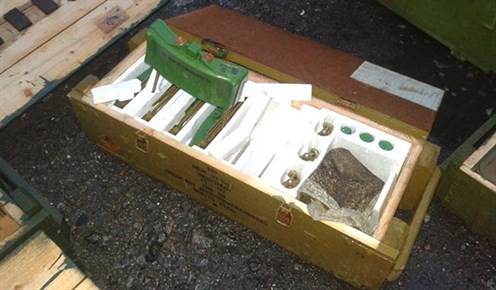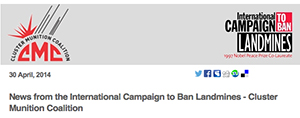23 January 2015
Is Ukraine using antipersonnel mines?
As a State Party to the Mine Ban Treaty, Ukraine must refrain from using antipersonnel mines at all times and under all circumstances. Recent troubling evidence sparks questions.

Mon-50 anti-personnel mines seized by Ukrainian military. ©glavnoe.ua
**Update**
On 6 April 2015, Human Rights Watch produced a technical brief note that reviews the types of landmines documented in the Ukraine conflict since early 2014, specifically focusing on mines that can function as antipersonnel mines.
****
23 January 2015
A news report from 15 December 2014 shows Ukrainian troops emplacing PDM-1M mines in the surf along a beach on the Sea of Azov, near the city of Mariupol. Such mines are designed to be detonated when 18-26 kilograms of force is applied to the VPDM-1M tilt rod fuze, an amount easily created by the actions of an adult. This means that while PDM-1M mines are meant to target land/water/amphibious vehicles, they can also be activated by a person.
The ICBL and the vast majority of States Parties that have expressed their views on victim-activation believe that any mine that can be activated by the unintentional act of a person is banned under the Mine Ban Treaty. Does Ukraine consider such mines to be permissible under the Mine Ban Treaty?
In addition to Ukraine’s obligations under the Mine Ban Treaty, Ukraine must ensure the effective exclusion of civilians from the effects of these mines, as required by the 1996 Amended Protocol II of the 1980 Convention on Certain Conventional Weapons (CCW). This would seem to be particularly difficult under the current circumstances.
In a letter sent to Minister of Foreign Affairs of Ukraine, the International Campaign to Ban Landmines asks clarifications on the use of reported landmines and calls on Ukraine to:
- confirm publicly whether PDM-1M mines have been used by Ukrainian troops, and in what location
- stop using PDM-1M mines as well as any other mines that can be activated by a person
- explain how it will ensure the effective exclusion of civilians from any mined area
- proceed to clearing PDM-1M and any other victim-activated mines in areas where they have been used.
Mines that can be victim-activated or command-detonated
MON-series and OZM-72 mines can be victim-activated, or command-detonated. Use in command-detonated mode is not prohibited by the Mine Ban Treaty, while victim-activation is prohibited. Both MON-series and OZM-72 mines have been documented in the so-called Anti-Terrorist Operations (ATO) zone. Ukraine should confirm publicly whether any victim-activated initiating devices (such as pull or tension release mechanical fuzes) used with MON-series and OZM-72 mines are or have been issued to any armed force or institution.
It is also clear from media reports that Russian-backed separatist fighters in the ATO zone are in possession of MON-series and OZM-72 mines. As a State Party to the Mine Ban Treaty, Ukraine should share any information it has regarding possible use of antipersonnel mines or any other type of victim-activated explosive devices by non-state actors in the ATO zone.
We hope that Ukraine will abide by the rules to which it willingly submitted itself when joining the 1996 Amended Protocol II to the CCW, and the 1997 Mine Ban Treaty. Compliance with these legal obligations will also help protect Ukraine’s own citizens.
Ukraine signed the Mine Ban Treaty on 24 February 1999 and ratified on 27 December 2005, becoming a State Party on 1 June 2006. Ukraine missed its 1 June 2010 treaty deadline for the destruction of all stockpiled antipersonnel mines and has therefore been in violation of the Mine Ban Treaty ever since.


